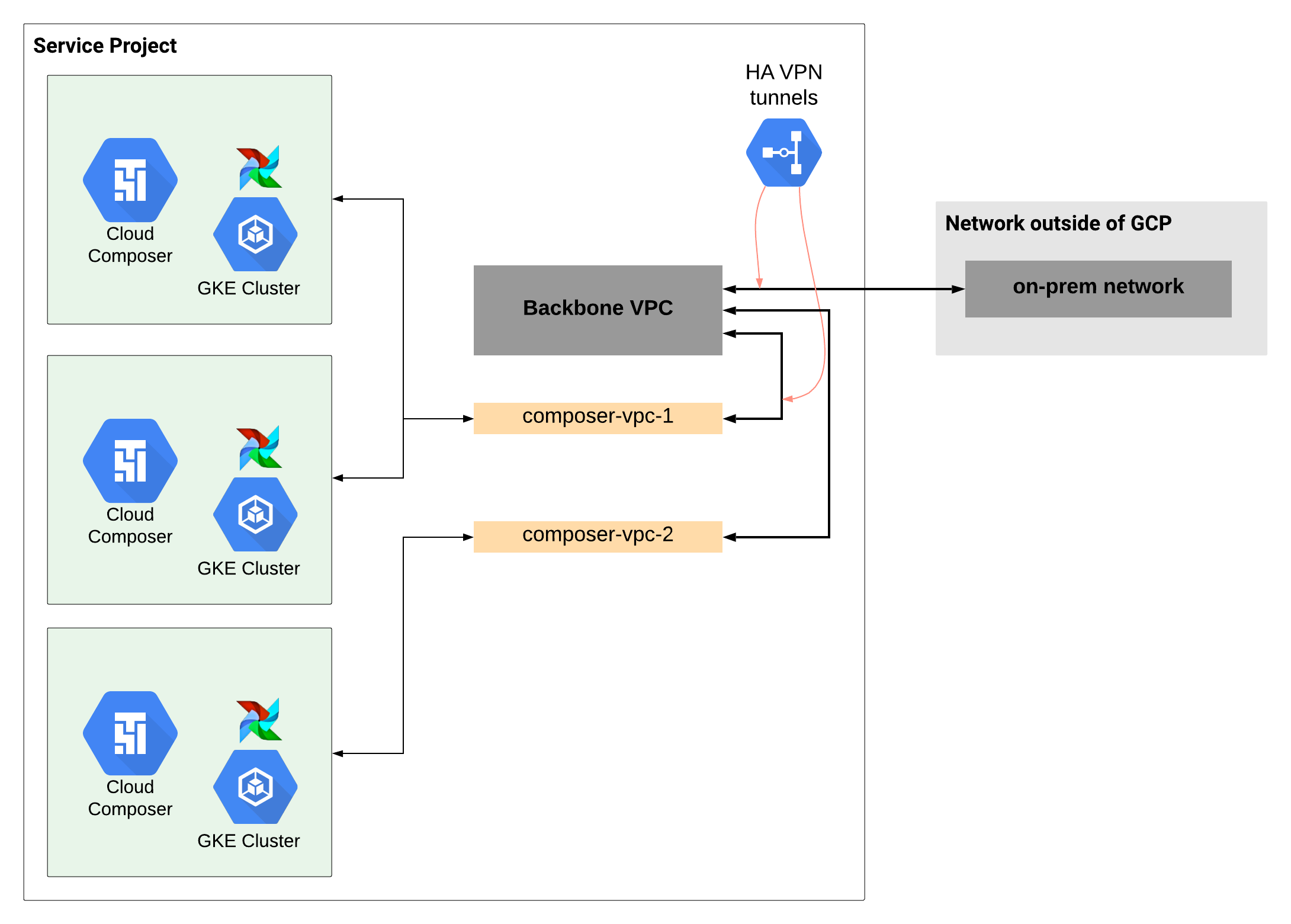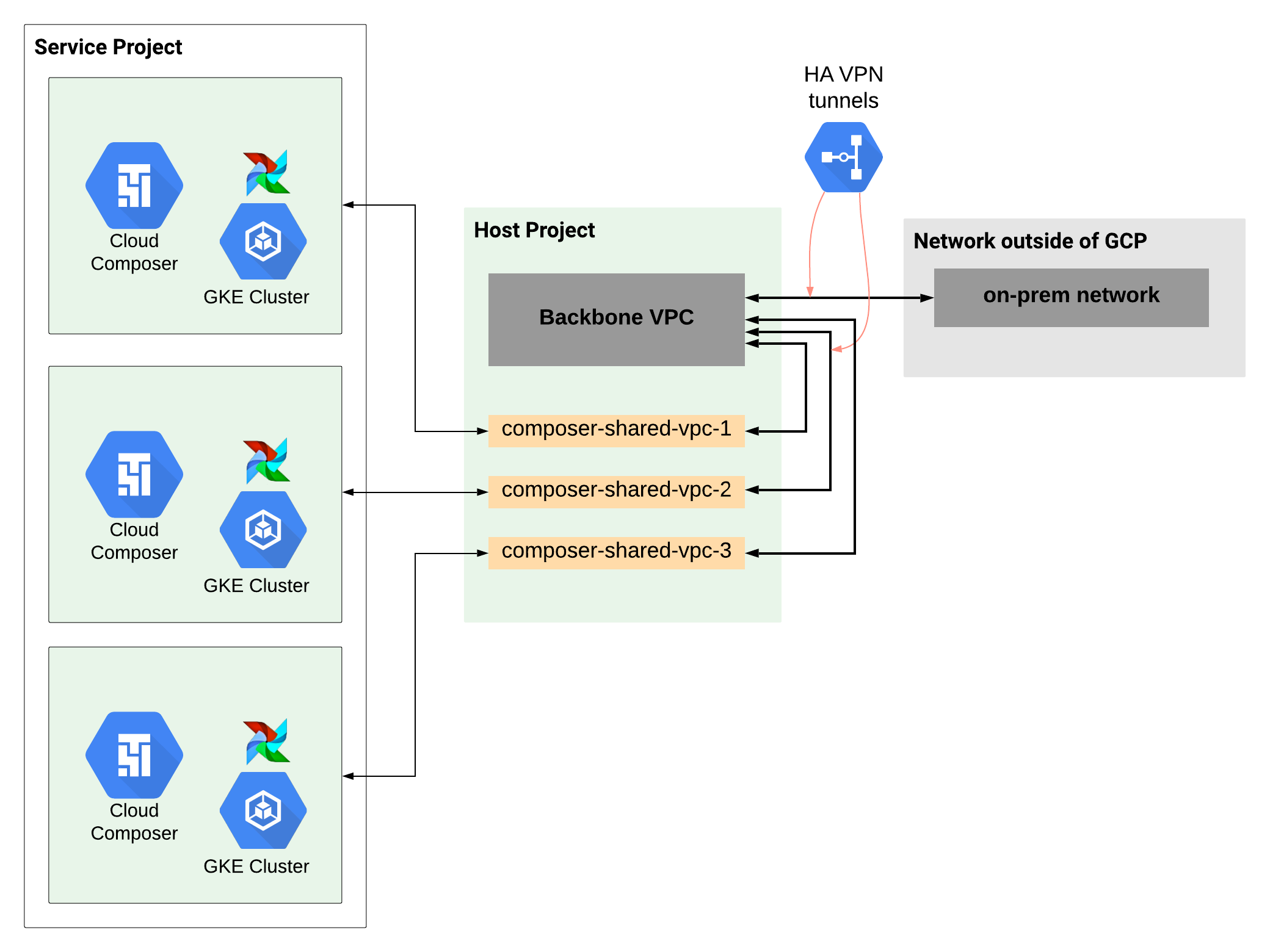Cloud Composer 3 | Cloud Composer 2 | Cloud Composer 1
このセクションでは、Cloud Composer 環境用に大規模なネットワークを整理する方法について説明します。
VPC、サブネット、転送ルールの割り当て
Cloud Composer と GKE サービスは、VPC ピアリングを使用して Cloud Composer 環境のコンポーネント(お客様のプロジェクトとテナント プロジェクト)間、および GKE クラスタと GKE コントロール プレーン間の接続を確立します。
プロジェクトに大規模なネットワーク構成(数百のネットワークと多数の VPC ピアリングが構成されているなど)が存在する場合は、新しい Cloud Composer 環境を作成しようとすると、VPC、サブネット、または転送ルールの割り当てエラーが原因でオペレーションが失敗する可能性があります。
発生する可能性のあるエラーは次のとおりです。
1 つの VPC ネットワークあたりの VPC ピアリングの最大数に達しています。
(この割り当ての引き上げをリクエストしない限り)単一 VPC 内の VPC ピアリングの数のデフォルトの割り当ては 25 です。
プライマリとセカンダリのサブネット IP 範囲の最大数に達しました。
このパラメータに対する割り当ては 400 です。
内部 TCP / UDP 負荷分散のピアリング グループ内の転送ルールの最大数に達しました。
このパラメータに対する割り当ては 175 です。
Google Cloudの VPC に対するデフォルト割り当ての詳細については、割り当てと上限をご覧ください。
Cloud Composer 環境のための大規模なネットワークについて
これらの制限に関連する課題を解決するために、以降のセクションで説明するように、Cloud Composer 環境をメインまたはバックボーンの VPC に接続されている複数の VPC ネットワークに編成できます。
このソリューションは、共有 VPC と非共有 VPC のシナリオに適用できます。
非共有 VPC シナリオでの大規模なネットワークの設定

Cloud Composer の大規模なネットワーク設定を作成するには、次のようにします。
バックボーン VPC ネットワークを作成します。このネットワークは、Cloud Composer 環境をホストする個々の VPC ネットワークのハブとして機能します。
Cloud Composer 環境用に専用 VPC ネットワークを作成します。複数の Cloud Composer 環境は 1 つの VPC ネットワークにまとめることができます。たとえば、これらのネットワークには、
composer-vpc-1、composer-vpc-2、… という名前を付けることができます。HA VPN トンネルを作成して、Cloud Composer 環境の VPC ネットワークとバックボーン VPC 間の接続を確立します。
共有 VPC シナリオでの大規模なネットワークの設定
共有 VPC ネットワークにおけるネットワーク ピアリング制限の問題を解決するには、Cloud Composer 環境を 1 つのバックボーン VPC に接続された複数のプロジェクトと VPC ネットワークに編成します。

Cloud Composer 用に大規模な共有 VPC ネットワーク設定を作成するには、次のようにします。
ホスト プロジェクトで、バックボーン VPC ネットワークを作成します。このネットワークは、Cloud Composer 環境を実行するサービス プロジェクトの個々の VPC ネットワークを接続します。
ホスト プロジェクトで、Cloud Composer 環境用の VPC ネットワークを作成します。たとえば、これらのネットワークには、
composer-shared-vpc-1、composer-shared-vpc-2、… という名前を付けることができます。手動で HA VPN トンネルを作成して、これらの VPC ネットワークとバックボーン VPC ネットワーク間の接続を確立します。
共有 VPC の設定で Cloud Composer 環境を構成します。

